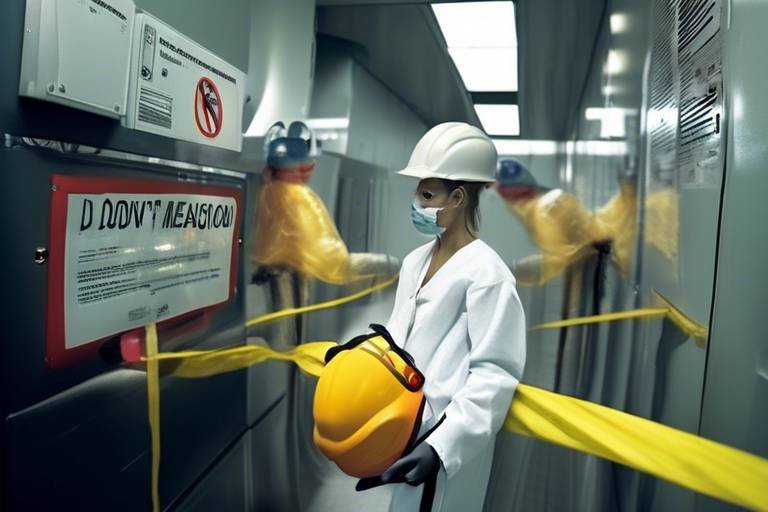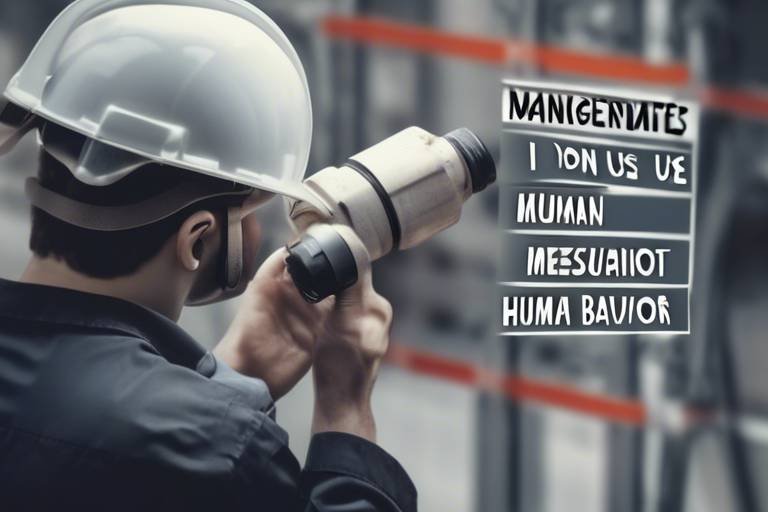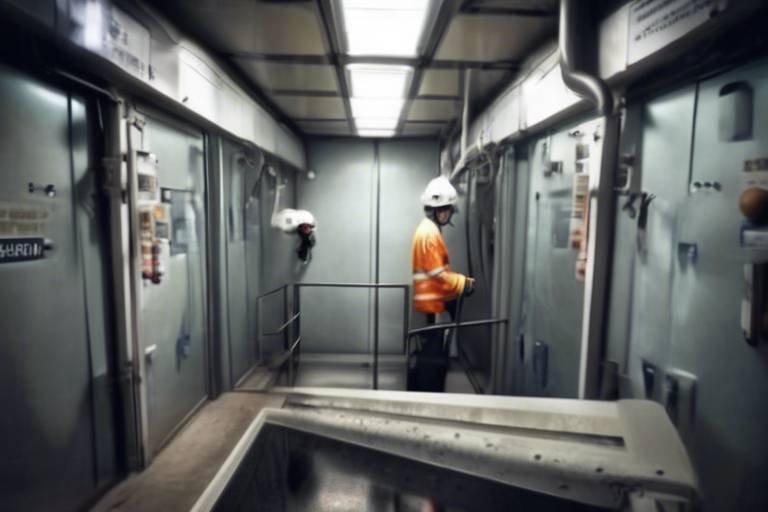Exploring the Correlation Between Human Behavior and Safety Measures
In today's fast-paced world, the interplay between human behavior and safety measures has never been more critical. Every day, we navigate environments that pose varying degrees of risk, whether at work, home, or in public spaces. But have you ever paused to consider how our psychological factors and emotional responses shape our understanding of safety? This article delves deep into the complex relationship between how we behave and the safety protocols designed to protect us. By examining this correlation, we can uncover insights that not only enhance our safety practices but also foster a culture of awareness and responsibility.
At the heart of this exploration lies the understanding that safety is not merely a set of rules to follow; it is deeply intertwined with how we perceive risk and make decisions. Our cognitive biases, such as overconfidence or the tendency to underestimate risks, can lead us to ignore safety measures. For instance, think about how many people skip wearing seatbelts because they believe “it won’t happen to me.” This mindset can have dire consequences. By understanding these psychological factors, we can better design safety protocols that resonate with individuals and encourage compliance.
Moreover, the effectiveness of safety measures often hinges on our willingness to adhere to them. Compliance is not just about following rules; it's about fostering an environment where safety is prioritized and ingrained in the culture. This means that organizations must actively engage in training, create incentives for safe behavior, and cultivate a workplace atmosphere that values safety as a collective responsibility. Imagine an office where every employee feels empowered to speak up about safety concerns; this is the kind of culture that can lead to significant improvements in overall safety.
In the sections that follow, we will dive deeper into the psychology of risk assessment, explore the importance of behavioral compliance, and examine the impact of environmental factors on safety practices. By the end of this article, you will have a comprehensive understanding of how human behavior influences safety measures, equipping you with the knowledge to foster a safer environment for yourself and those around you.
Understanding how individuals perceive risk is crucial in shaping safety measures. This section explores cognitive biases and emotional factors that affect decision-making in potentially dangerous situations.
This section discusses the importance of compliance with safety protocols and how individual behaviors can be influenced through training, incentives, and organizational culture to enhance overall safety.
Effective training programs are essential for promoting safety compliance. This subsection highlights best practices in designing training that resonates with employees, ensuring they understand and adhere to safety measures.
Interactive learning methods, such as simulations and role-playing, can significantly enhance engagement and retention of safety protocols among employees, leading to better compliance in real-world situations.
Regular assessment and feedback mechanisms are vital for reinforcing safe behaviors. This section examines how ongoing evaluations can help identify areas for improvement and ensure adherence to safety standards.
A strong safety culture within an organization can lead to better compliance. This subsection discusses how leadership and peer influence contribute to fostering a culture of safety.
Environmental factors play a significant role in shaping human behavior regarding safety. This section analyzes how physical surroundings and workplace design can either promote or hinder safe practices.
The principles of ergonomics are critical in creating safe work environments. This subsection explores how ergonomic design can reduce accidents and enhance employee well-being.
Advancements in technology have transformed safety measures. This section discusses the integration of technology, such as wearables and automation, in promoting safer behaviors among individuals in various settings.
- What are some common cognitive biases that affect safety behavior? Cognitive biases such as overconfidence, optimism bias, and the illusion of control can lead individuals to underestimate risks.
- How can organizations foster a culture of safety? Organizations can foster a culture of safety by providing comprehensive training, encouraging open communication about safety concerns, and recognizing safe behaviors.
- What role does technology play in workplace safety? Technology enhances workplace safety through tools like wearables that monitor health metrics, automation that reduces human error, and software that tracks compliance with safety protocols.

The Psychology of Risk Assessment
Understanding how individuals perceive risk is crucial in shaping safety measures. Risk assessment isn't just a cold, hard calculation; it's a complex interplay of emotions, experiences, and cognitive biases that can dramatically influence decision-making in potentially dangerous situations. For instance, have you ever noticed how some people seem to brush off safety warnings while others adhere to them religiously? This discrepancy often boils down to how we mentally process risk.
At the heart of this process are cognitive biases—systematic errors in thinking that affect our judgments and decisions. One common bias is the optimism bias, where individuals believe they are less likely to experience negative events than others. This can lead to a dangerous underestimation of risk. For example, a construction worker might feel invincible on the job site, ignoring safety protocols because they believe “accidents happen to someone else.” This mindset can create a perilous environment not just for the individual, but for their colleagues as well.
Another factor at play is the availability heuristic, where people assess the probability of an event based on how easily they can recall instances of it. If someone has never witnessed an accident at work, they may perceive their environment as safe, disregarding the necessary precautions. This is a classic case of letting personal experience cloud judgment. The irony is that the very absence of incidents can lead to a false sense of security, making it even more critical to implement robust safety measures that account for these psychological factors.
Emotional factors also play a significant role in risk assessment. Fear can be a double-edged sword; while it can compel individuals to take safety measures seriously, it can also lead to paralysis or avoidance. For instance, a worker who is overly fearful of heights may avoid necessary tasks altogether, potentially compromising their job performance and safety. It's essential for organizations to strike a balance—encouraging a healthy respect for risks without inducing crippling fear.
To effectively address these psychological intricacies, organizations can implement tailored training programs that not only educate employees about risks but also engage them emotionally. By using real-life scenarios and fostering open discussions about fears and biases, organizations can help employees recalibrate their perceptions of risk. This way, they can move from a place of ignorance or fear to one of informed caution and compliance.
Ultimately, understanding the psychology behind risk assessment is not just an academic exercise; it's a vital component of creating a safer workplace. By acknowledging cognitive biases, emotional responses, and the nuances of human behavior, we can design safety measures that resonate more deeply with individuals, leading to better compliance and a culture of safety.
- What is risk assessment? Risk assessment is the process of identifying, analyzing, and evaluating risks associated with potential hazards in a given environment.
- How do cognitive biases affect safety? Cognitive biases can lead individuals to underestimate risks, ignore safety protocols, or make poor decisions in dangerous situations.
- What role does emotional response play in risk assessment? Emotions like fear can either motivate individuals to adhere to safety measures or cause them to avoid situations altogether, impacting overall safety compliance.
- How can organizations improve safety compliance? Organizations can improve compliance by implementing effective training programs that address psychological factors influencing behavior and by fostering a strong safety culture.

Behavioral Compliance with Safety Protocols
When it comes to safety protocols, compliance isn’t just a box to check; it’s a vital part of creating a secure environment. Think about it—when you’re driving a car, you buckle up not just because it’s the law, but because you know it could save your life. Similarly, in workplaces, behavioral compliance with safety protocols can be the difference between a safe day at work and a potentially hazardous situation. But what drives this compliance? Is it fear of punishment, a desire to please, or something deeper?
One of the key factors influencing compliance is training. Effective training programs can transform employees' understanding of safety measures from a mere obligation to a personal commitment. When individuals are educated about the risks associated with their tasks and the protocols designed to mitigate those risks, they are more likely to adhere to these guidelines. It’s like teaching someone to swim; once they understand the importance of staying afloat, they’ll be more likely to practice safety in the water.
Moreover, incentives play a crucial role in promoting compliance. Imagine a scenario where employees are rewarded for adhering to safety protocols. This could be in the form of recognition, bonuses, or even simple thank-you notes from management. When employees feel appreciated for their safe practices, it fosters a positive feedback loop, encouraging them to maintain these behaviors. In fact, organizations that implement incentive programs often see a marked improvement in compliance rates.
Another significant aspect is the organizational culture. A workplace that prioritizes safety creates an environment where compliance becomes second nature. If leadership demonstrates a commitment to safety, employees are more likely to follow suit. It’s like a ripple effect; when management takes safety seriously, it sends a message that everyone should do the same. This culture can be cultivated through regular safety meetings, open communication about safety issues, and by encouraging employees to voice their concerns without fear of retribution.
To further illustrate the importance of compliance, let’s consider the following table that highlights the impact of various factors on behavioral compliance:
| Factor | Impact on Compliance |
|---|---|
| Training Programs | Enhances understanding and retention of safety protocols |
| Incentives | Motivates employees to adhere to safety measures |
| Organizational Culture | Fosters a shared commitment to safety |
| Feedback Mechanisms | Identifies areas for improvement and reinforces safe behaviors |
In conclusion, behavioral compliance with safety protocols is a multifaceted issue that requires a comprehensive approach. By investing in training, offering incentives, and fostering a strong safety culture, organizations can significantly enhance compliance rates among their employees. It’s not just about following rules; it’s about creating a safe environment where everyone feels responsible for their own safety and that of their colleagues. So, why not take a moment to reflect on your workplace’s safety practices? Are they effective, or is there room for improvement?
- What are the key factors influencing compliance with safety protocols? Training, incentives, and organizational culture are crucial to enhancing compliance.
- How can training programs improve safety compliance? Effective training increases understanding and retention of safety measures, leading to better adherence.
- What role do incentives play in promoting safety? Incentives motivate employees to follow safety protocols by providing recognition and rewards.
- How can an organization foster a safety culture? By prioritizing safety in leadership decisions, encouraging open communication, and recognizing safe practices.

The Role of Training Programs
When it comes to ensuring safety in any environment, training programs serve as the backbone of compliance and awareness. Imagine stepping into a workplace where every individual is not just aware of the safety protocols but is also actively engaged in practicing them. This is the power of effective training programs. They are not merely a checkbox to tick off; they are a dynamic tool that can transform an organization's safety culture. The challenge, however, lies in designing these programs in a way that resonates with employees and encourages them to internalize the safety measures.
One of the most effective approaches to training is to make it interactive. Traditional training methods, such as lectures or PowerPoint presentations, often fail to capture the attention of employees. Instead, incorporating interactive learning techniques—like simulations, role-playing, and hands-on activities—can significantly enhance engagement. For example, consider a fire drill where employees not only learn the evacuation routes but also participate in a mock emergency scenario. This kind of immersive experience allows individuals to practice their responses in a safe environment, making them more likely to remember and execute those actions during a real emergency.
Another crucial aspect of training programs is the incorporation of continuous assessment and feedback. Regular evaluations can help identify knowledge gaps and reinforce safe behaviors. For instance, after completing a training module, employees could undergo a short quiz or practical demonstration to assess their understanding. This not only helps in reinforcing the material but also provides valuable insights into areas that may require further training. By fostering an environment where feedback is both given and received, organizations can ensure that their safety protocols are not just understood but are actively practiced.
To illustrate the importance of these elements, let’s take a look at a simple comparison of traditional vs. modern training approaches:
| Aspect | Traditional Training | Modern Training |
|---|---|---|
| Engagement Level | Low | High |
| Retention Rate | Moderate | High |
| Feedback Mechanism | Rare | Frequent |
| Real-World Application | Theoretical | Practical |
In summary, the role of training programs in promoting safety compliance cannot be overstated. A well-structured training initiative that emphasizes interactive learning and ongoing feedback will not only empower employees but also cultivate a culture of safety within the organization. After all, when individuals feel confident in their knowledge and skills, they are more likely to adhere to safety protocols, ultimately leading to a safer workplace for everyone.
- What are the key components of an effective safety training program? An effective program should include interactive training methods, regular assessments, and continuous feedback.
- How often should safety training be conducted? It is advisable to conduct safety training at least annually, with refresher courses as needed based on workplace changes or incidents.
- Can technology enhance safety training? Absolutely! Integrating technology like virtual reality and online modules can make training more engaging and accessible.

Interactive Learning Techniques
When it comes to enhancing safety compliance, stand out as a powerful approach. Imagine a training session where employees are not just passive listeners but active participants. This kind of engagement can significantly boost retention and understanding of safety protocols. Traditional methods, like lectures or slide presentations, often lead to a lack of interest and poor information retention. In contrast, interactive techniques create an immersive experience that resonates with individuals on a deeper level.
One of the most effective methods is the use of simulations. By simulating real-life scenarios, employees can practice their responses to potential hazards in a safe environment. For instance, consider a fire evacuation drill. Instead of just discussing procedures, employees can experience the drill firsthand, which not only reinforces the importance of the protocol but also helps them remember what to do in an actual emergency. This experiential learning fosters a sense of preparedness and confidence among employees.
Another engaging technique is role-playing. This method allows participants to step into different roles within a safety scenario, encouraging them to think critically about their actions and decisions. For example, in a manufacturing setting, one employee might enact the role of a safety officer while another plays a worker who has just spotted a potential hazard. This interactive approach not only enhances understanding but also promotes teamwork and communication, vital components of a robust safety culture.
Furthermore, incorporating technology into training sessions can elevate the learning experience. Virtual reality (VR) and augmented reality (AR) are becoming increasingly popular in safety training. These technologies provide immersive environments where employees can practice safety protocols without the risks associated with real-life situations. Imagine a construction worker using VR to navigate a construction site and identify safety hazards before stepping onto the actual site. This kind of training can significantly reduce accidents and enhance overall safety awareness.
To make the most of these interactive techniques, organizations should consider the following best practices:
- Incorporate a variety of methods to cater to different learning styles.
- Encourage feedback and discussion among participants to enhance learning.
- Regularly update training materials to reflect the latest safety standards and practices.
In conclusion, interactive learning techniques are not just a trend; they are a vital component of effective safety training. By fostering an engaging learning environment, organizations can ensure that employees not only understand safety protocols but also feel empowered to implement them in their daily routines. This proactive approach can lead to a significant reduction in workplace accidents and create a culture where safety is prioritized by everyone.
Q1: What are interactive learning techniques?
A1: Interactive learning techniques are training methods that actively engage participants, allowing them to practice and apply knowledge through simulations, role-playing, and technology integration.
Q2: Why are simulations important in safety training?
A2: Simulations provide a safe environment for employees to experience real-life scenarios, reinforcing their understanding of safety protocols and preparing them for actual emergencies.
Q3: How can technology enhance safety training?
A3: Technologies like virtual reality and augmented reality offer immersive experiences that allow employees to practice safety measures without real-world risks, significantly improving retention and engagement.

Continuous Assessment and Feedback
In the realm of safety compliance, serve as the lifeblood that nourishes a culture of safety within an organization. Think of it as a feedback loop that not only reinforces safe behaviors but also illuminates areas that require improvement. Just as a gardener tends to their plants, ensuring they receive adequate water and sunlight, organizations must nurture their safety protocols through regular evaluations. This ongoing process allows leaders to identify potential hazards before they escalate into serious incidents.
One of the most effective strategies for fostering a culture of safety is the implementation of regular assessment mechanisms. These can take various forms, such as scheduled safety audits, peer reviews, and self-assessments. Each method provides valuable insights into how well safety protocols are being followed and where adjustments may be necessary. For instance, consider the following approaches:
- Safety Audits: Conducting comprehensive audits allows organizations to evaluate their current safety measures against established standards, ensuring compliance and identifying gaps.
- Peer Reviews: Encouraging employees to observe and review each other's adherence to safety practices fosters a sense of accountability and teamwork.
- Self-Assessments: Empowering employees to assess their own practices encourages personal responsibility and proactive engagement with safety measures.
Moreover, feedback is not merely a one-way street; it should be a dynamic conversation between management and employees. When employees receive constructive feedback, it creates an opportunity for dialogue, allowing them to express their concerns and suggestions. This interaction not only enhances their understanding of safety protocols but also makes them feel valued and heard. For instance, when a worker reports a near-miss incident and receives acknowledgment and guidance on safer practices, it reinforces their commitment to safety.
To truly embed continuous assessment and feedback into the organizational culture, it’s crucial to establish a feedback-friendly environment. Leaders should actively encourage open communication and reassure employees that their input is essential for improving safety. This can be achieved through:
- Regular Safety Meetings: Hosting frequent meetings dedicated to discussing safety issues and sharing feedback can promote transparency and collective problem-solving.
- Anonymous Reporting Systems: Implementing systems that allow employees to report safety concerns anonymously can help surface issues that might otherwise go unaddressed.
In summary, continuous assessment and feedback are indispensable tools for enhancing safety compliance within organizations. By fostering an environment where feedback is welcomed and acted upon, organizations can not only prevent accidents but also empower their employees to take ownership of their safety practices. Just as a ship needs a compass to navigate through turbulent waters, organizations need continuous feedback to steer their safety protocols in the right direction.
Q: Why is continuous assessment important for safety compliance?
A: Continuous assessment helps identify potential risks and ensures that safety protocols are being adhered to, ultimately preventing accidents and improving workplace safety.
Q: How can feedback improve employee engagement in safety practices?
A: When employees receive constructive feedback, it fosters open communication and makes them feel valued, encouraging them to actively participate in safety initiatives.
Q: What are some effective methods for conducting safety assessments?
A: Effective methods include safety audits, peer reviews, and self-assessments, each providing unique insights into compliance and areas for improvement.

Influence of Organizational Culture
The organizational culture within a workplace is like the invisible thread that weaves together the behaviors, beliefs, and values of its employees. Imagine walking into a company where safety is prioritized; the atmosphere feels different, doesn’t it? Employees are more likely to adhere to safety protocols when they work in an environment that actively promotes and values safety. This is not just a matter of policy; it's about creating a culture where safety is ingrained in the daily operations and mindset of every individual.
A strong safety culture can significantly enhance compliance with safety measures. When leadership demonstrates a genuine commitment to safety, it sets a precedent for the rest of the organization. Employees are more likely to mirror the attitudes and behaviors of their leaders. For instance, if a manager consistently wears personal protective equipment (PPE) and emphasizes its importance, employees are likely to follow suit. This phenomenon is known as social influence, where individuals are swayed by the actions and attitudes of those around them.
Furthermore, peer influence plays a critical role in shaping safety behaviors. In environments where employees feel supported by their colleagues, they are more inclined to speak up about unsafe practices or conditions. This creates a feedback loop that fosters accountability. To illustrate this, consider a scenario where a team member notices a safety hazard. If the culture encourages open dialogue and constructive criticism, that employee will feel empowered to address the issue, leading to a safer workplace for everyone.
To cultivate a robust safety culture, organizations should focus on several key aspects:
- Leadership Commitment: Leaders must visibly prioritize safety in their decision-making and daily actions.
- Employee Involvement: Engaging employees in safety discussions and initiatives promotes a sense of ownership.
- Recognition and Rewards: Acknowledging safe behaviors reinforces their importance and encourages others to follow suit.
In addition, regular training and communication about safety practices can further solidify this culture. When employees are kept informed about new safety protocols or changes, they are more likely to feel included and valued. This, in turn, can lead to a more proactive approach to safety. Companies that invest in their employees’ safety education and training not only enhance compliance but also boost morale and productivity.
In conclusion, the influence of organizational culture on safety compliance cannot be overstated. It is the foundation upon which effective safety practices are built. By fostering a culture where safety is a shared value, organizations can create an environment that not only protects employees but also enhances overall productivity and job satisfaction. The ripple effect of a strong safety culture is profound, leading to a workplace that thrives on mutual respect, accountability, and well-being.
Q1: What is organizational culture?
A1: Organizational culture refers to the shared values, beliefs, and behaviors that shape how work gets done within an organization. It influences how employees interact with one another and approach their tasks.
Q2: How does leadership affect safety culture?
A2: Leadership plays a crucial role in shaping safety culture by setting an example. When leaders prioritize safety, it encourages employees to do the same, fostering a work environment that values safety.
Q3: Can peer influence impact safety compliance?
A3: Yes, peer influence can significantly impact safety compliance. When employees support and encourage each other to adhere to safety protocols, it creates a collective responsibility towards maintaining a safe workplace.
Q4: What are some ways to improve safety culture?
A4: Improving safety culture can be achieved through leadership commitment, employee involvement, regular training, and recognition of safe behaviors, fostering an environment where safety is a shared priority.

The Impact of Environmental Factors
When we think about safety, it’s easy to focus solely on protocols and human behavior, but have you ever considered how our surroundings influence our actions? Environmental factors play a pivotal role in shaping human behavior regarding safety. The way a workplace is designed, the tools available, and even the overall atmosphere can either encourage safe practices or lead to accidents. It's almost like the environment acts as a silent partner in our daily operations, guiding our actions in ways we might not even realize.
For instance, consider a cluttered workspace. When desks are piled high with paperwork, tools, and other materials, it can create a chaotic environment. This chaos not only makes it harder to find necessary items but also increases the chances of accidents. A clear and organized space, on the other hand, can promote focus and reduce risks. It’s like having a clear path in a forest; you can navigate safely without tripping over unseen roots or branches.
Moreover, the physical layout of a workplace can significantly impact safety. For example, if emergency exits are not clearly marked or easily accessible, it can lead to confusion in critical situations. A well-designed layout that considers the flow of movement can facilitate quick evacuations and reduce panic. This is where the concept of ergonomics comes into play, as it focuses on designing workspaces that enhance efficiency and safety.
To further illustrate the importance of environmental factors, let’s look at a few key elements:
- Lighting: Adequate lighting is essential in preventing accidents. Poorly lit areas can hide hazards and lead to slips or falls.
- Noise Levels: Excessive noise can distract employees, making it harder to concentrate on tasks and increasing the likelihood of errors.
- Temperature: Extreme temperatures can affect physical performance and alertness, which are critical for maintaining safety.
By understanding these factors, organizations can implement changes that promote a safer environment. For example, investing in better lighting, reducing noise through soundproofing, and ensuring comfortable temperature control can all contribute to a culture of safety. It’s about creating an environment where safety is ingrained in the daily routine, almost like second nature.
In conclusion, the impact of environmental factors on safety cannot be overstated. Just like a well-tended garden flourishes, a carefully designed workspace can lead to a culture of safety where employees feel secure and focused. By recognizing and addressing these environmental influences, organizations can significantly enhance their safety measures and ultimately protect their most valuable asset: their people.
- How do environmental factors influence safety in the workplace?
Environmental factors such as lighting, noise levels, and workspace organization can significantly affect employee behavior and safety compliance. - What role does ergonomics play in workplace safety?
Ergonomics focuses on designing workspaces that enhance comfort and efficiency, which can reduce the risk of accidents and injuries. - Can technology improve workplace safety?
Yes, technology such as wearables and safety monitoring systems can provide real-time feedback and alerts, enhancing overall safety.

Ergonomics and Safety Design
When it comes to creating a safe workplace, ergonomics plays a pivotal role that is often underestimated. Imagine a world where your workspace feels as comfortable as your favorite chair at home. That’s the essence of ergonomic design—it’s about more than just comfort; it’s about enhancing safety and productivity. By understanding how the human body interacts with its environment, we can design workplaces that not only prevent injuries but also promote overall well-being.
Consider this: every year, millions of workers suffer from musculoskeletal disorders (MSDs) caused by poor workplace ergonomics. These injuries can lead to chronic pain, reduced productivity, and increased healthcare costs. Therefore, implementing ergonomic principles is not just a good idea; it’s a necessity. Ergonomic design focuses on optimizing the fit between the worker and their work environment, which can significantly reduce the risk of injury.
Key elements of ergonomic design include:
- Adjustable Workstations: Desks and chairs that can be easily adjusted to fit the individual’s height and posture.
- Proper Tool Design: Tools that minimize strain on the body, such as handles that fit comfortably in the hand.
- Clear Visibility: Ensuring that screens and materials are positioned to reduce neck and eye strain.
Moreover, ergonomic design isn’t just limited to physical aspects; it also encompasses the psychological environment. A well-designed workspace can enhance employee morale and motivation. For instance, incorporating natural light, plants, and personal space can create a more pleasant atmosphere that encourages productivity and reduces stress. It’s like giving employees a breath of fresh air in their daily grind!
Furthermore, organizations that prioritize ergonomic safety see tangible benefits. According to numerous studies, companies that invest in ergonomic solutions report:
| Benefit | Impact |
|---|---|
| Reduced Injury Rates | Up to 40% decrease in workplace injuries |
| Increased Productivity | Boost of 10-30% in employee output |
| Improved Employee Satisfaction | Higher retention rates and morale |
In conclusion, the integration of ergonomic principles into safety design is not merely a trend; it’s a fundamental shift towards creating healthier, safer work environments. By investing in ergonomic solutions, organizations are not only protecting their most valuable asset—their employees—but also setting the stage for enhanced productivity and reduced costs. So, the next time you sit at your desk, take a moment to appreciate the design around you. It could be the difference between comfort and injury, productivity and stagnation.
- What is ergonomics?
Ergonomics is the science of designing the workplace, keeping in mind the capabilities and limitations of the worker. - How can ergonomic design improve safety?
By optimizing the workspace and tools, ergonomic design reduces the risk of injuries and enhances comfort, leading to a safer work environment. - What are common ergonomic issues in the workplace?
Common issues include poor posture, repetitive strain injuries, and inadequate workstation setups. - Are ergonomic solutions expensive?
While some ergonomic solutions may require an upfront investment, they often lead to long-term savings by reducing injury rates and increasing productivity.

Technology's Role in Enhancing Safety
In today's fast-paced world, technology plays a pivotal role in enhancing safety across various sectors. Imagine a workplace where potential hazards are detected before they can cause harm, or where employees are equipped with tools that not only protect them but also promote a proactive safety culture. This is not just a dream; it’s a reality made possible by innovative technological advancements.
One of the most significant contributions of technology to safety is the integration of wearable devices. These gadgets, such as smart helmets and vests, are designed to monitor the health and safety of workers in real-time. For instance, smart helmets equipped with sensors can alert employees to potential hazards in their environment, such as low oxygen levels or harmful gas concentrations. This immediate feedback can be the difference between a safe workday and a dangerous incident. Furthermore, wearables can track vital signs, ensuring that employees are not overexerting themselves, which is crucial in physically demanding jobs.
Another transformative aspect is the use of automation in safety procedures. Robots and automated systems can take on hazardous tasks, reducing human exposure to dangerous conditions. For example, in construction, drones can survey sites from above, identifying risks without putting workers at risk. This not only enhances safety but also improves efficiency, allowing human workers to focus on tasks that require their expertise. The integration of automation can also streamline safety protocols, ensuring that checks and balances are consistently applied without the variability of human error.
Moreover, the advent of smart technology in the workplace has led to the development of systems that can predict and prevent accidents. For example, advanced analytics and machine learning algorithms can analyze data from various sources—like machinery performance and environmental conditions—to identify patterns that may indicate impending safety issues. By addressing these concerns before they escalate, organizations can foster a safer working environment.
However, while technology significantly enhances safety measures, it is essential to remember that it should complement, not replace, human judgment. Training employees to effectively use these technologies is crucial. For instance, if workers do not understand how to interpret data from wearable devices or automated systems, the technology becomes less effective. Therefore, organizations must prioritize training and education alongside technological implementation.
In summary, technology is revolutionizing safety protocols in ways we never thought possible. From wearables that monitor health to automation that reduces risk, the future of workplace safety is bright. As we continue to embrace these advancements, it's vital to foster a culture of safety that values both human insight and technological innovation.
- How do wearable devices enhance workplace safety?
Wearable devices monitor health metrics and environmental conditions, providing real-time alerts to workers about potential hazards. - What role does automation play in safety?
Automation can take over dangerous tasks, reducing the risk of human injury and streamlining safety processes. - Why is training important when implementing new safety technologies?
Training ensures that employees know how to use new technologies effectively, maximizing their safety benefits. - Can technology predict safety issues before they occur?
Yes, advanced analytics can identify patterns that indicate potential safety problems, allowing for proactive measures.
Frequently Asked Questions
- What is the connection between human behavior and safety measures?
Human behavior significantly influences the effectiveness of safety measures. People’s perceptions of risk, their compliance with protocols, and their reactions to training all play a crucial role in how safety practices are implemented and followed.
- How do cognitive biases affect risk assessment?
Cognitive biases can skew our perception of risk, leading individuals to underestimate or overestimate dangers. For example, someone might ignore safety protocols because they feel invincible or have a false sense of security, which can lead to unsafe situations.
- Why is compliance with safety protocols important?
Compliance with safety protocols is vital as it helps prevent accidents and injuries. When individuals follow established guidelines, it creates a safer environment for everyone. Training and a positive organizational culture can enhance this compliance.
- What role do training programs play in promoting safety?
Training programs are essential for educating employees about safety protocols. They provide the knowledge and skills necessary to recognize hazards and respond appropriately. Effective training engages employees and reinforces the importance of safety in their daily tasks.
- How can interactive learning techniques improve safety training?
Interactive learning techniques, such as simulations and role-playing, make training more engaging and memorable. By actively participating in scenarios, employees are more likely to retain information and apply it in real-life situations, leading to better safety outcomes.
- What is the significance of organizational culture in safety compliance?
A strong safety culture fosters an environment where safety is prioritized. When leadership demonstrates a commitment to safety and encourages open communication, employees are more likely to feel responsible for adhering to safety practices and supporting their peers.
- How do environmental factors influence safety behaviors?
Environmental factors, such as workplace design and ergonomics, can either promote or hinder safe practices. A well-designed workspace reduces the likelihood of accidents and encourages safe behaviors, while a poorly designed environment can lead to increased risks.
- What role does technology play in enhancing safety?
Technology has revolutionized safety measures by introducing tools like wearables and automation. These technologies can monitor employee behaviors, provide real-time feedback, and streamline safety processes, making it easier for individuals to adhere to safety protocols.



















